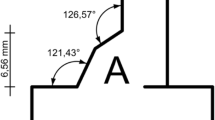Abstract
A procedure for optimally designing light-weight and reliable welded structures is proposed and applied to the structural design of an illustrative welded structure used in construction and transportation machinery. To verify the effectiveness of the design procedure, the designed structures were experimentally produced, and then the fatigue lives of them were evaluated. The proposed design procedure is composed of two major processes; one is thickness-design process, and the other one is the process for designing weld type. Since the design for thickness and weld type is conducted sequentially, the thickness of welded structures can be determined in an optimization process without considering weld type; hence, the proposed design procedure is not computational demanding. In the thickness-design process, the thickness of a target welded structure is optimized by constraining structural stress that is estimated on the basis of the International Institute of Welding recommendations. After the thickness optimization, weld type of welded joints is designed by using local-notch stress, which is also defined in the IIW recommendations. Two kinds of test pieces based on the designed welded structure were experimentally produced by changing the weld type of a joint, and the test pieces were fatigue tested to verify their fatigue resistance. Since the produced welded structures had expected fatigue resistance, it can be concluded that welded structures can be optimally designed by using the proposed design procedure.























Similar content being viewed by others
References
ASME (2007) ASME boiler & pressure vessel code. ASME, New York
Dong PA (2001) Structural stress definition and numerical implementation for fatigue analysis of welded joints. Int J Fatigue 23:865–876
Eurocode 3 (2005) Design of steel structures. European Committee for Standardization, Brussels
Hobbacher A. (2008) Recommendations for Fatigue Design of Welded Joints and Components. IIW Doc. XIII-2151r3-07/XV-1254r3-07. Int Inst Welding
Hobbacher AF (2009) The new IIW recommendations for fatigue assessment of welded joints and components – A comprehensive code recently updated. Int J Fatigue 31:50–58
Jarmai K, Farkas J (1999) Cost calculation and optimization of welded steel structures. J Constructional Steel Res 50:115–135
Maddox SJ (2001) Recommended Hot-Spot Stress Design S-N Curves for Fatigue Assessment of FSPO. Proceedings of the 11th International Offshore and Polar Engineering Conference, Stavanger, Norway
Niemi E, Fricke W, Maddox SJ (2006) Fatigue analysis of welded components. IIW Doc. XII-1430-00. Int Inst Welding
Radaj D, Soncino CM, Fricke W (2009) Recent development in local concepts of fatigue assessment of welded joints. Int J Fatigue 31:2–11
Selvakumar P, Hong JK (2013) Robust mesh insensitive structural stress method for fatigue analysis of welded structures. Procedia Engineering 55:374–379
Simoes LMC, Farkas J, Jarmai K (2009) Reliability-based optimum design of welded steel cellular plates. Proceedings of 8th World Congress on Structural and Multidisciplinary Optimization, Lisbon, Portugal
Soncino CM, Fricke W, de Bruyne F, Hoppe A, Ahmadi A, Zhang G (2012) Notch stress concepts for the fatigue assessment of welded joints – Background and applications. Int J Fatigue 34:2–16
Takeda N, Naruse T (2013) Can we optimally design light-weight welded structures with sufficient fatigue resistance? Proceedings of 10th World Congress on Structural and Multidisciplinary Optimization, Florida, USA
Takeda N, Kita Y, Papalambros PY (2011) Optimization of welded structures with structural hot spot constraints. Proceedings of 9th World Congress on Structural and Multidisciplinary Optimization, Shizuoka, Japan
Tanese R (1989) Distributed genetic algorithms. Proceedings of the Third International Conference on Genetic Algorithms, edited by Schaffer J. D., Morgan Kaufman: 434–439
Vogt M, Dilger K, Kassner M (2012) Investigations on different fatigue design concepts using the example of a welded crossbeam connection from the underframe of a steel railcar body. Int J Fatigue 34:47–56
Author information
Authors and Affiliations
Corresponding author
Rights and permissions
About this article
Cite this article
Takeda, N., Naruse, T. Optimal design of welded structure with structural and local-notch stresses based on International Institute of Welding recommendations. Struct Multidisc Optim 51, 1133–1147 (2015). https://doi.org/10.1007/s00158-014-1201-0
Received:
Revised:
Accepted:
Published:
Issue Date:
DOI: https://doi.org/10.1007/s00158-014-1201-0




